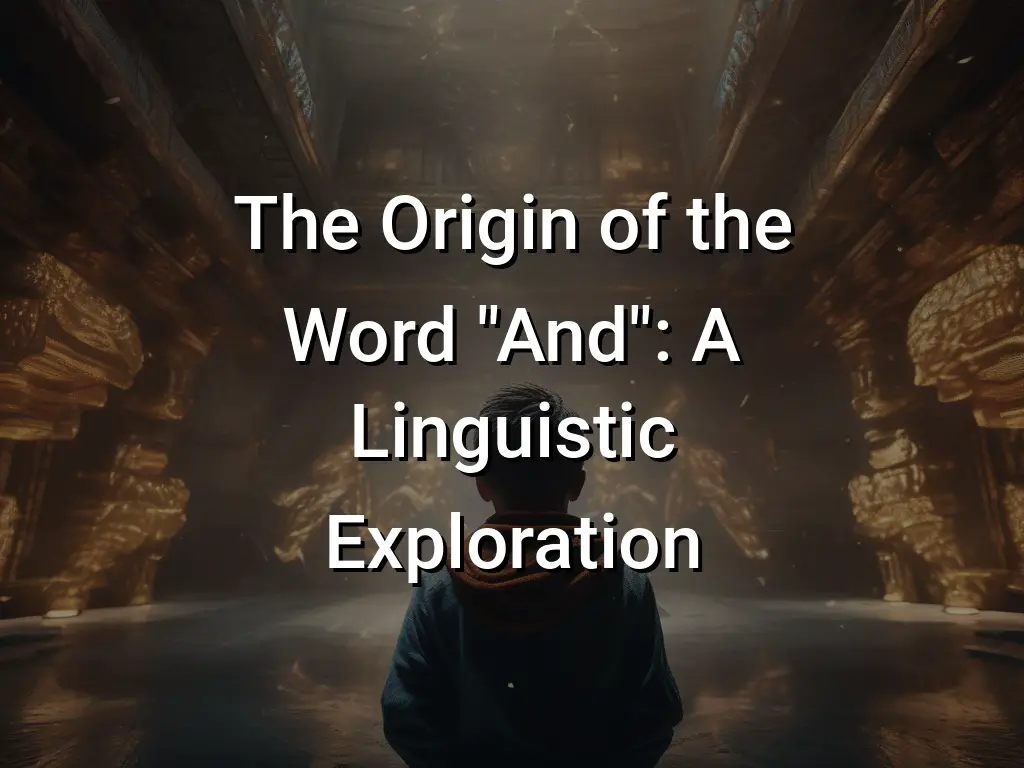The Origin of the Word “And”: A Linguistic Exploration

Have you ever wondered about the origin of the word “and”? While it may seem like a simple, everyday word, “and” has a fascinating linguistic history that dates back thousands of years.
In this article, we will explore the etymology of the word “and” and how it has evolved over time. From its ancient roots to its usage in modern languages, we will delve into the rich and diverse history of this seemingly insignificant conjunction.
Etymology of the Word “And”
The word “and” has an ancient and fascinating history that dates back to the earliest known human languages. Its etymology can be traced back to Proto-Indo-European, the ancestor of many modern languages spoken today. The Proto-Indo-European word “h₂énti” is believed to be the root of “and” and is related to the Latin word “et,” the Greek word “kaí,” and the Sanskrit word “ca.”
- The word “and” entered the English language from Old English, where it was spelled as “and,” “ond,” or “end.”
- Its origins can be further traced back to the Germanic word “andi” and the Proto-Germanic word “andi” or “endiz.”
- In Old English, “and” was used as a conjunction to denote addition or combination.
- Over time, the spelling and pronunciation of “and” evolved to its current form.
- The word “and” is one of the most frequently used words in English and serves as a critical component of sentence structure and communication.
The etymology of “and” provides insights into the interconnectedness of languages and how they have evolved and influenced one another over centuries. In the next section, we will explore the historical development of the word “and” and its significance in different languages.
Historical Development of the Word “And”
The word “and” has a rich history that can be traced back to ancient times. Linguists have studied its evolution and development across different languages and cultures. Here is a brief overview of the historical development of the word “and” followed by a numbered list of key points:
- Ancient Languages: The concept of “and” can be found in ancient languages such as Sanskrit, Ancient Greek, and Latin. These languages had their own unique words and grammatical structures to express the notion of “and.”
- Proto-Indo-European: The word “and” can be traced back to the Proto-Indo-European language, the hypothetical ancestor of many modern European and Indian languages. In this ancient language, the word “h₂énti” was used to signify “and.”
- Evolution in Germanic Languages: In Germanic languages like Old English and Old High German, the word “and” evolved from the Proto-Germanic word “andi.” Over time, it underwent phonetic changes and modifications, leading to the variations seen in modern Germanic languages.
- Grammatical Changes: The grammatical functions and usage of the word “and” have also evolved over time. In some languages, it functions as a coordinating conjunction, connecting words, phrases, or clauses. In other languages, it may serve as a particle or even a prefix.
- Global Influence: As languages spread and interacted through trade, colonization, and cultural exchanges, the word “and” found its way into various languages around the world. However, the specific phonetic form and grammatical usage of “and” may vary in different linguistic contexts.
Exploring the historical development of the word “and” provides insights into the linguistic evolution of human communication. In the next section, we will delve into the grammatical functions and uses of “and” in different languages.
Grammatical Functions and Uses of “And” in Different Languages
The word “and” is a fundamental conjunction found in nearly all languages. It serves various grammatical functions and has different uses across different linguistic systems. Here are some examples of how “and” is used in different languages:
- English: “And” is used to join words, phrases, or clauses that are of equal importance or have a coordinating relationship. For example: “John and Mary went to the store.”
- Spanish: In Spanish, “y” is the equivalent of “and” and is used in a similar way to English. For example: “Juan y María fueron a la tienda.”
- French: The word “et” is used as “and” in French. It is used to connect words or phrases. For example: “Pain et beurre” (Bread and butter).
- German: In German, “und” is used as “and”. It is used to connect words, phrases, or clauses. For example: “Ich bin müde und hungrig” (I am tired and hungry).
- Japanese: The Japanese word for “and” is “と” (to). It is used to join nouns and verb phrases. For example: “リンゴとオレンジ” (Apple and orange).
These are just a few examples of how “and” is used in different languages. The specific usage and grammatical functions of “and” can vary greatly depending on the language and its grammar rules. Understanding these variations is essential for effective language learning and translation.
Significance of the Word “And” in Linguistics
The word “and” is a fundamental element of language and plays a crucial role in linguistic communication. It serves as a conjunction that connects words, phrases, or clauses. The significance of the word “and” in linguistics can be observed in various aspects of language structure and function.
Conclusion
The word “and” has a rich and complex linguistic history. From its etymology, which traces back to ancient Indo-European languages, to its historical development and grammatical functions in different languages, “and” has played a crucial role in human communication for centuries.
Understanding the significance of “and” in linguistics can provide valuable insights into how languages have evolved and how they continue to shape our understanding of the world. Whether it’s connecting words, phrases, or ideas, “and” serves as a bridge that brings concepts together and allows for the expression of complex thoughts and relationships.
So next time you use the word “and” in your conversations or writing, take a moment to appreciate its linguistic significance and the power it holds in connecting and enriching our language.